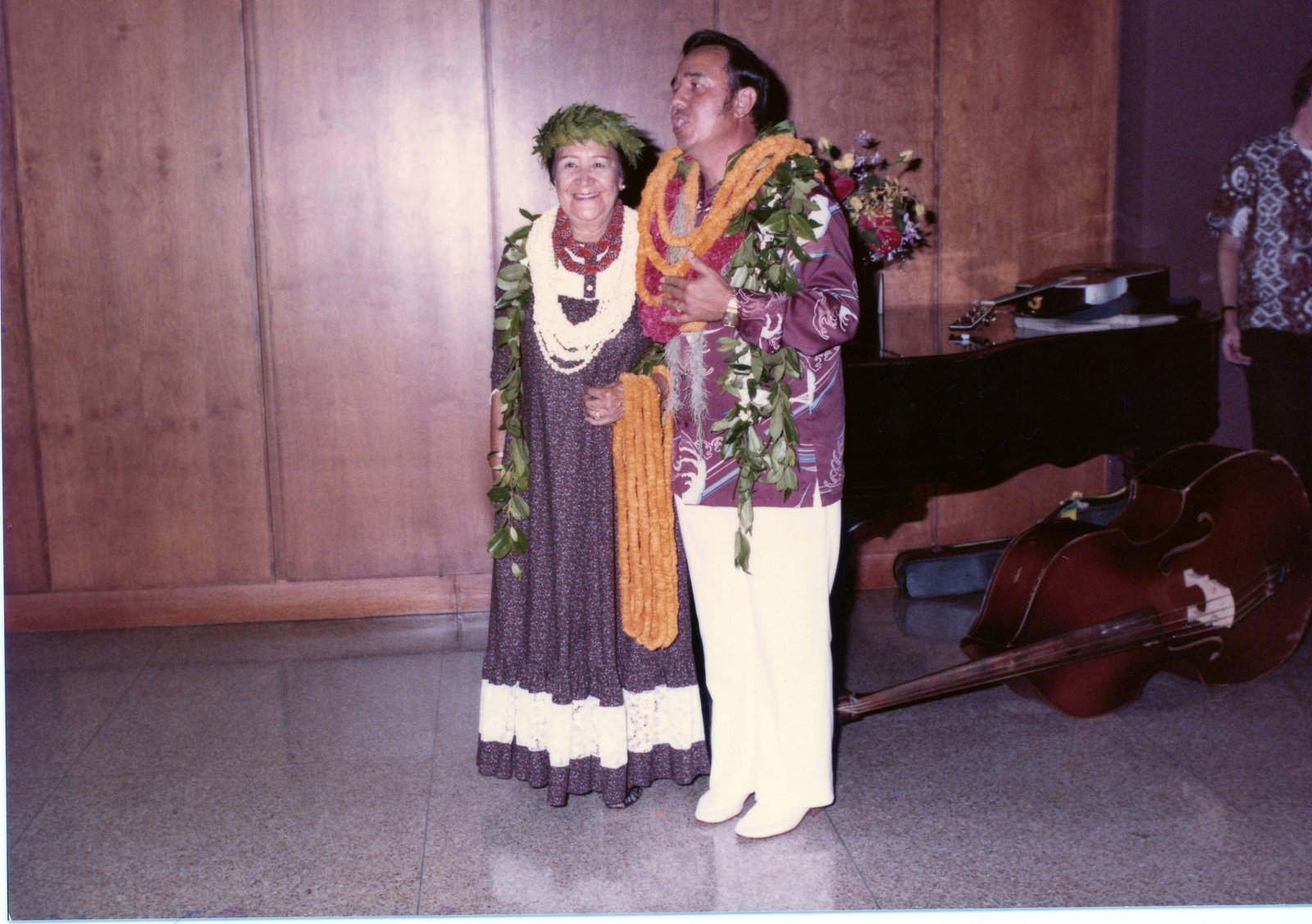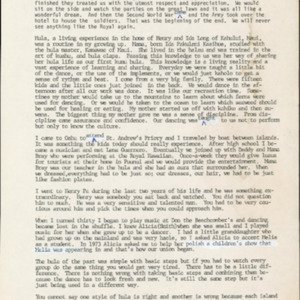Mae Ulalia Loebenstein
Title
Mae Ulalia Loebenstein
Subject
Nā Kumu Hula Mae Ulalia Loebenstein text from Nānā I Na Loea Hula Vol One Page 94
Description
Mae Loebenstein is the daughter of the late Ida Long of Kahului, Maui and currently works in collaboration with Alicia Smith of Halau 0 Na Maoli Pua.
The hula, as I was growing up in the home of my parents Henry and Ida Long of Kahului, Maui, was a vital, living experience. Mama, born Ida Pakulani Kaaihue, studied with the hula master Kamawae of Maui. She lived in the halau and was trained in the art of kuahu and hula ‘olapa. As our first kumu hula, Mama shared the knowledge of her halau life with us.
This knowledge is a living reality based on a vast experience of learning and sharing. Everyday we were taught a little bit about the dance — kaholo to get a sense of rhythm and beat or how to use the implements. We learned kahiko first and then ‘auwana. We would dance in the afternoon after all our chores were done.
It was our recreation time. My mother would take us to the mountains to learn which ferns were used for dancing or to the ocean to learn which seaweed was used for healing or for eating.
The most precious gift my mother gave me through hula was a sense of discipline. Discipline develops assurance and confidence. Mama taught us hula as a way to know our culture and heritage rather than for entertaining.
I came to 0‘ahu to attend St. Andrews Priory, and in those days the only way to travel between islands was by ship. That’s an experience that today’s children have missed. After high school I became a musician and met Lena Guerrero. Eventually, we joined Daddy and Mama Bray who were performing at the Royal Hawaiian Hotel. Once a week, the Brays would have a lu‘au at their home in Pu‘unui for the tourists and we would provide the entertainment. Mama Bray had an aura of mysticism about her and as our teacher in the hula, she helped to develop a natural fashion sense in hula costuming and it’s overall effect on the dance.
So me of my fondest memories are of the years I spent as an entertainer at the Royal Hawaiian Hotel. That was an era of elegance and gentility. It was like Cinderella going to the Grand Ball every night of the week. Everything was the finest. The guests of the hotel during that period were either celebrities or wealthy people from all over the world. When we performed, the audience was quiet and attentive. When we finished, they applauded with respect and appreciation. After performing, we would sit on the side and watch the parties on the great lawn. It was all like a wonderful dream. With the Second World War, the Army took over the hotel to house the soldiers on Rest and Recuperation leave. That was the beginning of the end. We will never see anything like the days of the old Royal Hawaiian Hotel again.
When I turned thirty, I began to play music at Don the Beachcombers and hula was lost in the shuffle. Lei Collins, Sally Wood, and I were the musicians with Rosalie Stephenson as vocalist. ‘Iolani Luahine was the featured dancer. Later I entertained with Bill Lincoln at the Kahala Hiltons Maile Room for ten years.
My youngest granddaughter was born on the Mainland and was raised in the Haole way. Maelia was two-and-a-half when she was sent home to live and be Hawaiian. I asked Alicia (Smith) to accept my mo‘opuna as a hula student. In 1973 Alicia asked me to help her polish a keiki show in which Maelia was a participant. That’s how our association in the halau began.
I went to Henry Pa during the last two years of his life. Uncle Henry was an extraordinary man, sensitive and talented — a great artist. He was someone you sat back and observed. You did not question him too much. You had to be cautious and pick the times when best to approach him.
The hula of old was a simple dance with a few basic steps. The same basic steps were used to express the hula in a distinctive style by each island and each district. That is why we should not say that one style of hula is right and another is not. There is nothing wrong with taking the same basic steps and combining them to make the dance look fresh and new. With age, wisdom comes. As we grow older we learn to value our culture. What may have seemed unimportant in our youth becomes very precious as we grow in years and experience.
The hula, as I was growing up in the home of my parents Henry and Ida Long of Kahului, Maui, was a vital, living experience. Mama, born Ida Pakulani Kaaihue, studied with the hula master Kamawae of Maui. She lived in the halau and was trained in the art of kuahu and hula ‘olapa. As our first kumu hula, Mama shared the knowledge of her halau life with us.
This knowledge is a living reality based on a vast experience of learning and sharing. Everyday we were taught a little bit about the dance — kaholo to get a sense of rhythm and beat or how to use the implements. We learned kahiko first and then ‘auwana. We would dance in the afternoon after all our chores were done.
It was our recreation time. My mother would take us to the mountains to learn which ferns were used for dancing or to the ocean to learn which seaweed was used for healing or for eating.
The most precious gift my mother gave me through hula was a sense of discipline. Discipline develops assurance and confidence. Mama taught us hula as a way to know our culture and heritage rather than for entertaining.
I came to 0‘ahu to attend St. Andrews Priory, and in those days the only way to travel between islands was by ship. That’s an experience that today’s children have missed. After high school I became a musician and met Lena Guerrero. Eventually, we joined Daddy and Mama Bray who were performing at the Royal Hawaiian Hotel. Once a week, the Brays would have a lu‘au at their home in Pu‘unui for the tourists and we would provide the entertainment. Mama Bray had an aura of mysticism about her and as our teacher in the hula, she helped to develop a natural fashion sense in hula costuming and it’s overall effect on the dance.
So me of my fondest memories are of the years I spent as an entertainer at the Royal Hawaiian Hotel. That was an era of elegance and gentility. It was like Cinderella going to the Grand Ball every night of the week. Everything was the finest. The guests of the hotel during that period were either celebrities or wealthy people from all over the world. When we performed, the audience was quiet and attentive. When we finished, they applauded with respect and appreciation. After performing, we would sit on the side and watch the parties on the great lawn. It was all like a wonderful dream. With the Second World War, the Army took over the hotel to house the soldiers on Rest and Recuperation leave. That was the beginning of the end. We will never see anything like the days of the old Royal Hawaiian Hotel again.
When I turned thirty, I began to play music at Don the Beachcombers and hula was lost in the shuffle. Lei Collins, Sally Wood, and I were the musicians with Rosalie Stephenson as vocalist. ‘Iolani Luahine was the featured dancer. Later I entertained with Bill Lincoln at the Kahala Hiltons Maile Room for ten years.
My youngest granddaughter was born on the Mainland and was raised in the Haole way. Maelia was two-and-a-half when she was sent home to live and be Hawaiian. I asked Alicia (Smith) to accept my mo‘opuna as a hula student. In 1973 Alicia asked me to help her polish a keiki show in which Maelia was a participant. That’s how our association in the halau began.
I went to Henry Pa during the last two years of his life. Uncle Henry was an extraordinary man, sensitive and talented — a great artist. He was someone you sat back and observed. You did not question him too much. You had to be cautious and pick the times when best to approach him.
The hula of old was a simple dance with a few basic steps. The same basic steps were used to express the hula in a distinctive style by each island and each district. That is why we should not say that one style of hula is right and another is not. There is nothing wrong with taking the same basic steps and combining them to make the dance look fresh and new. With age, wisdom comes. As we grow older we learn to value our culture. What may have seemed unimportant in our youth becomes very precious as we grow in years and experience.
Citation
“Mae Ulalia Loebenstein,” Nā Kumu Hula Archive, accessed July 2, 2025, https://nakumuhula.org/archive/items/show/18.












